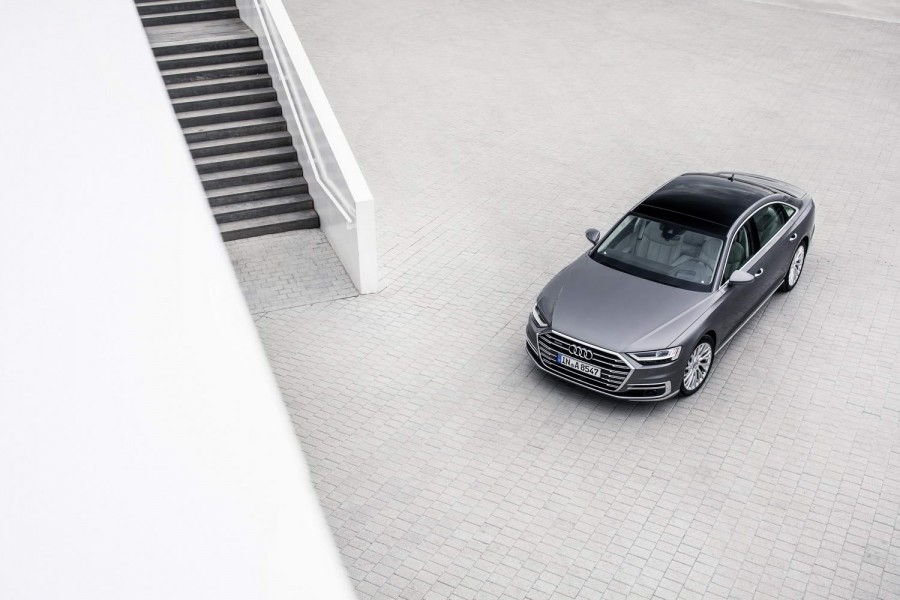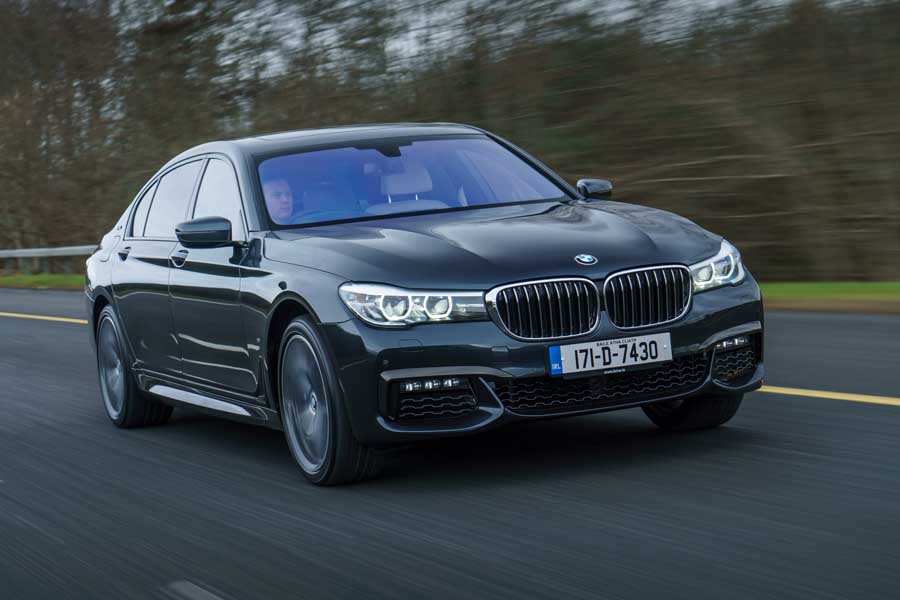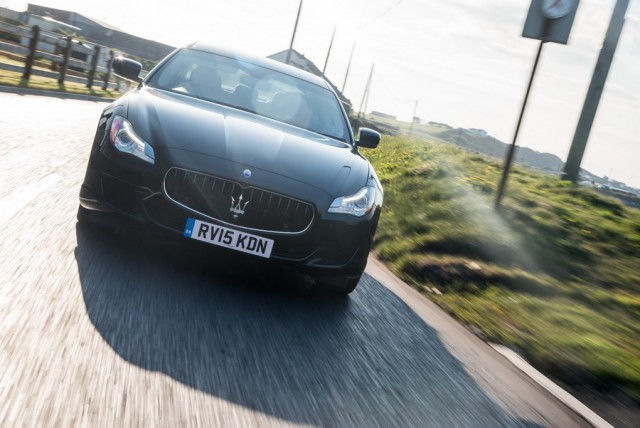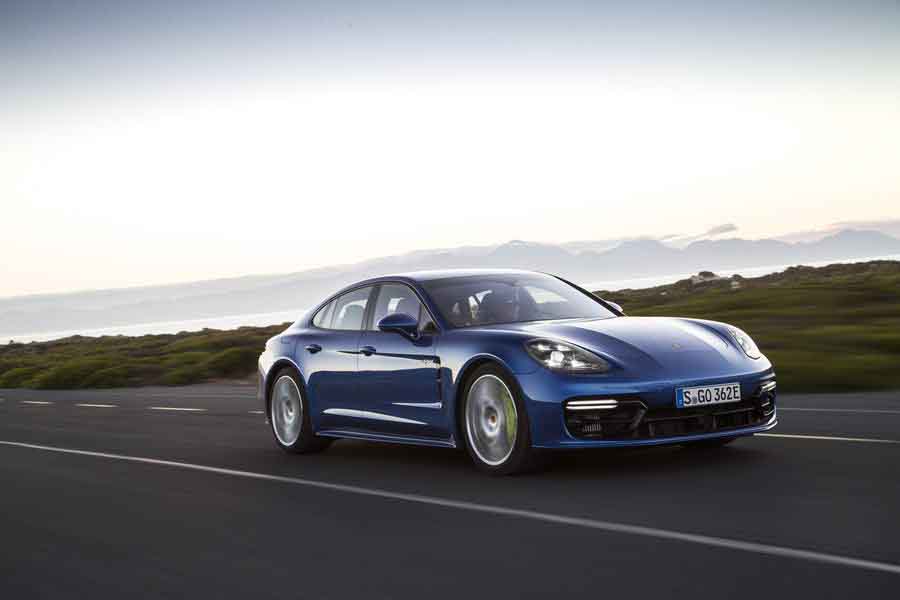In creating its new flagship luxury saloon, Audi has given the A8 some of the most advanced technology and safety systems ever seen in series production. But, crucially, it also delivers refinement on an impressive scale and a quality of finish befitting the price tag.
In the metal
While the new Audi A8 is undoubtedly sharper looking than before, you'd never mistake it for a car from any other brand and, being critical, we think Audi could have moved the game on a little further in this area. All of the usual features of a new Audi model are there, including tauter body panels, sharper creases along the shoulder line and an even bolder front grille. Pay close attention and you will spot some intricate new features, though, such as the 'tornado line' that runs into the rear and gently blends into the body as it meets the boot lid. It's a tiny detail but one that requires a very complex manufacturing process. Few will notice or appreciate it, but it shows Audi's desire to create a premium product, even if some will think that this is a facelifted car rather than entirely new model.
If you want to have your A8 looking its best, you will need to tick several option boxes. The standard wheelbase version isn't exactly a small car at 5,172 millimetres in length, 37mm longer than its predecessor, but it lacks the added presence provided by the longer wheelbase, which stretches the distance between the wheels by 130mm. Seeing both cars side by side gives the impression that the long wheelbase version was designed first, as it's more cohesive. The impressive looking OLED rear light design will also require delving into your pocket for. Its eye-catching design and trick light animation that plays when opening or locking the car is almost worth the price alone. Standard models get an LED setup that looks slightly different, but retains that full-width light bar across the boot lid.
However, it is inside that Audi has most obviously upped its design game. Immediately noticeable is the centre console, which features two high definition colour touchscreens surrounded by a gloss black panel reaching across the full width of the cabin. The upper screen measures 10.1 inches and is used for the infotainment, satellite navigation and various connected services along with controls for the car's setup. When not required, the display can be switched off and its black panel technology makes it blend almost invisibly into the panel that surrounds it. It immediately awakens with a touch, while using it on the move is made easier by its haptic feedback.
The lower mounted 8.6-inch screen contains controls for temperature and ventilation, seat heating and massage functions. What strikes you about the A8's cabin is how few physical switches there are given the number of elements that can be controlled. Where there isn't a touchscreen there are touch-sensitive buttons. Adjusting the strength of the ventilation is done by just sliding your finger along the touch bar that emits a similar reassuring click to the now retired MMI rotary controller, while the side and fog lights are on one single touch panel. Even the hazard lights are activated by touch. As for the rest of the cabin the finish is superb. Finishes like open-pore wood panels contrast beautifully with the ultra-modern machined surfaces that surround the few physical buttons. Regardless of which seat you choose to occupy, the choice of heating, massage and ventilation are enough to make any journey distance just melt away.
Driving it
Audi has added to its suite of assistance systems, although the headline act, the AI autonomous driving function, is not yet permitted for use until the appropriate legislation has been passed. Aptly, many would argue that the Audi A8 is a car to be driven in, rather than taking control of the wheel yourself. Some will be lucky enough to only experience Audi's latest luxury car from the rear, but for now we're going to focus on how it drives.
On the move the A8 rides well thanks to its standard fitment of adaptive air suspension. On some of the near-perfect tarmac roads we tested the car on it was, expectedly, serene in how it wafted along. But there were occasions when the suspension didn't quite feel like the magic carpet ride you might expect. Depending on the surface there was an audible rumble from the tyres even if you scroll through the multiple Drive Select modes that range from Comfort to Dynamic. More interestingly, the test route included one unpaved section of road that was heavily rutted. The A8 lapped it up with aplomb, coping with and suppressing the surface at a rate that many SUVs would struggle with.
As with the suspension, the steering weight can be changed to reflect the chosen driving mode. In most settings it feels very light to the touch, turning from lock to lock so freely you would question if there was any kind of link to the front axle at all. This makes a city commute a bit more relaxing. Dynamic mode adds some weight, but this feels just as digitised. It is a setup that isn't going to appeal to drivers that relish analogue feedback from the wheel. All A8s come with Audi's quattro all-wheel-drive transmission as standard and the traction levels are excellent. Power distribution between the axles feels very even and the tuning of the adaptive air suspension results in almost the entire elimination of body roll and pitch when driving.
The 3.0-litre diesel engine is likely to remain the most popular choice for A8 buyers in Ireland. Like the rest of the engines offered, it includes a 'mild hybrid' system. Unlike traditional hybrid systems, which allow some driving under battery power, usually as slow speeds, this mild hybrid setup allows the engine to switch off for short periods when cruising at speed. It does this though a small 10Ah lithium-ion battery that is recharged through driving, so there's no need for owners to plug it in.
On-board cameras help detect suitable conditions, typically with no traffic in front, and allow the engine to shut off at speeds up to 160km/h for as long as 40 seconds at a time. To the driver there is little to tell that this is occurring other than the digital tachometer on the 12.3-inch Virtual Cockpit dropping to zero rpm. The battery keeps all of the systems such as power steering, braking and other ancillary systems running while the engine is off. By using a belt alternator starter (BAS), it allows for seamless restarting of the engine at speed. Crucial to this is the revised automatic transmission, which is kept primed by the battery. Audi claims that the mild hybrid system can save up to 0.7 litres/100km of fuel. While the way in which the battery and engine interact impresses at the smoothness, we found only a handful of occasions where the system actually activated.
The 12.3-inch Virtual Cockpit is as it appears in other Audi models, though has some new design features. Drivers can also choose to switch the head-up display on and off as they wish. It is larger than the type used before and has a high level of clarity to its full colour display. It can show all relevant driving information such as traffic sign recognition and route directions from the satnav.
As for the diesel motor, it makes good use of the eight-speed automatic transmission, keeping engine speeds generally low. Its 600Nm of torque rolls in at just 1,250rpm giving it plenty of pleasing low-down grunt. Given the weight of expectations around refinement, the engine doesn't sound quite as well-insulated as perhaps it could. While it is far from gruff, there is still a more diesel-like tone from it, especially as you ply on the revs. Considering the impressive work Audi's engineers have done in muting diesel engines in the likes of the A5 Coupe and Q5, we feel there is still some room for improvement in the A8.
What you get for your money
The Audi A8 can be fitted with no shortage of options, adding to the price, and that's before you delve into the even more personalised Audi Exclusive offerings. What may frustrate some potential buyers is that much of the technology is either not yet available (the Level 3 autonomous driving function), or can only be specified in accordance with the larger engines. For example, the impressive Audi AI Active Suspension is not available on the 3.0-litre diesel, petrol V6 or forthcoming plug-in hybrid models.
Pricing in Ireland will start at €99,950 for the 3.0-litre TDI car, while the Luxury model, which should be the most popular, is expected to start at approximately €107,000. Exact specifications are still in the process of being finalised, but these are expected to follow a similar structure to the existing Audi range with three distinct grades.
The entry level SE model will have the Audi Virtual Cockpit, MMI Navigation Plus with MMI Touch Response, Head-up Display, Adaptive Cruise Control, Audi Active Lane Assist, Audi Side Assist and a Smartphone Interface that is compatible with Apple and Android devices.
A higher Luxury grade, in addition to the SE specification, adds Matrix LED headlights with dynamic indicators, Audi Phonebox wireless charging, upgraded 19-inch alloy wheels, 360-degree parking cameras, acoustic glazing for added sound insulation, 22-way electrically adjustable front seats, Valcona leather upholstery and the chrome exterior package.
We will update this section of the review when the full pricing structure is confirmed.
Summary
As a luxury saloon the new Audi A8 scores well in all of the key areas. Its reserved styling will sit well with many buyers, though some may long for something more extrovert. The full potential of the A8 has yet to be seen as its autonomous driving tech remains on hold until sufficient legislation has been passed to permit its use on public roads, but even so, it's an accomplished upgrade over its predecessor.



































































